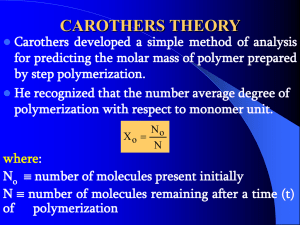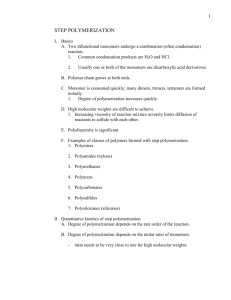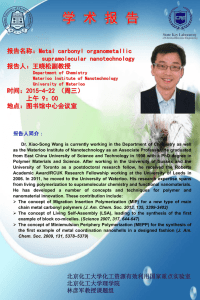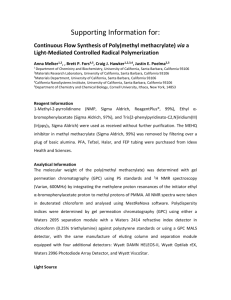pola28025-sup-0001-suppinfo
advertisement
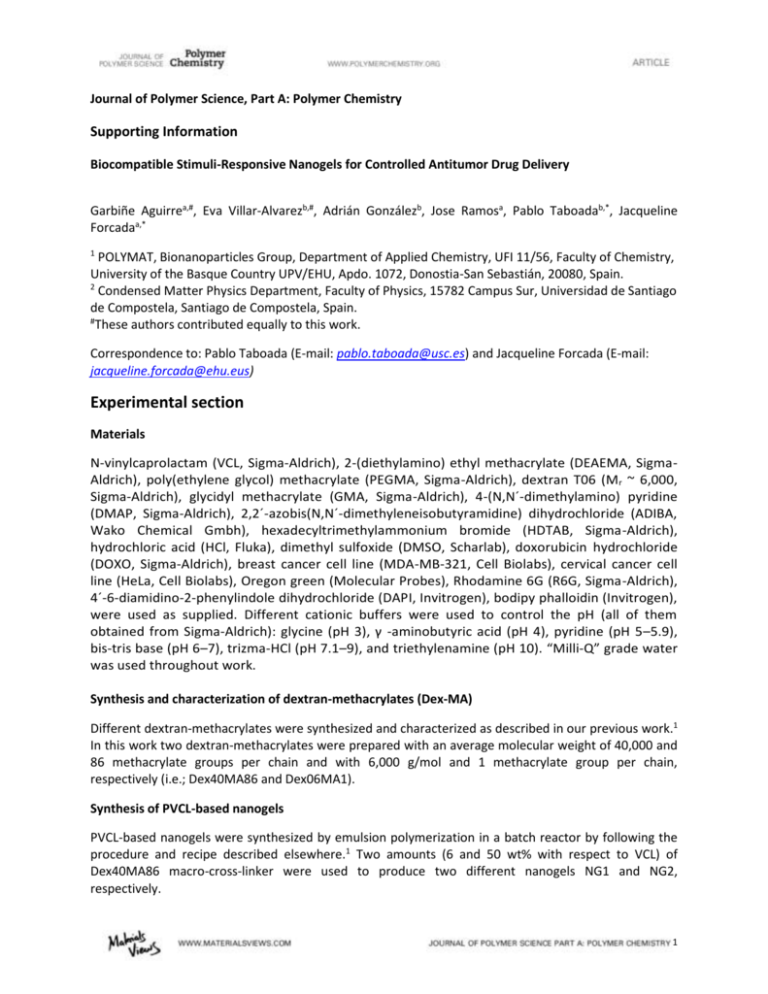
Journal of Polymer Science, Part A: Polymer Chemistry Supporting Information Biocompatible Stimuli-Responsive Nanogels for Controlled Antitumor Drug Delivery Garbiñe Aguirrea,#, Eva Villar-Alvarezb,#, Adrián Gonzálezb, Jose Ramosa, Pablo Taboadab,*, Jacqueline Forcadaa,* 1 POLYMAT, Bionanoparticles Group, Department of Applied Chemistry, UFI 11/56, Faculty of Chemistry, University of the Basque Country UPV/EHU, Apdo. 1072, Donostia-San Sebastián, 20080, Spain. 2 Condensed Matter Physics Department, Faculty of Physics, 15782 Campus Sur, Universidad de Santiago de Compostela, Santiago de Compostela, Spain. # These authors contributed equally to this work. Correspondence to: Pablo Taboada (E-mail: pablo.taboada@usc.es) and Jacqueline Forcada (E-mail: jacqueline.forcada@ehu.eus) Experimental section Materials N-vinylcaprolactam (VCL, Sigma-Aldrich), 2-(diethylamino) ethyl methacrylate (DEAEMA, SigmaAldrich), poly(ethylene glycol) methacrylate (PEGMA, Sigma-Aldrich), dextran T06 (M r ~ 6,000, Sigma-Aldrich), glycidyl methacrylate (GMA, Sigma-Aldrich), 4-(N,N´-dimethylamino) pyridine (DMAP, Sigma-Aldrich), 2,2´-azobis(N,N´-dimethyleneisobutyramidine) dihydrochloride (ADIBA, Wako Chemical Gmbh), hexadecyltrimethylammonium bromide (HDTAB, Sigma-Aldrich), hydrochloric acid (HCl, Fluka), dimethyl sulfoxide (DMSO, Scharlab), doxorubicin hydrochloride (DOXO, Sigma-Aldrich), breast cancer cell line (MDA-MB-321, Cell Biolabs), cervical cancer cell line (HeLa, Cell Biolabs), Oregon green (Molecular Probes), Rhodamine 6G (R6G, Sigma-Aldrich), 4´-6-diamidino-2-phenylindole dihydrochloride (DAPI, Invitrogen), bodipy phalloidin (Invitrogen), were used as supplied. Different cationic buffers were used to control the pH (all of them obtained from Sigma-Aldrich): glycine (pH 3), γ -aminobutyric acid (pH 4), pyridine (pH 5–5.9), bis-tris base (pH 6–7), trizma-HCl (pH 7.1–9), and triethylenamine (pH 10). “Milli-Q” grade water was used throughout work. Synthesis and characterization of dextran-methacrylates (Dex-MA) Different dextran-methacrylates were synthesized and characterized as described in our previous work.1 In this work two dextran-methacrylates were prepared with an average molecular weight of 40,000 and 86 methacrylate groups per chain and with 6,000 g/mol and 1 methacrylate group per chain, respectively (i.e.; Dex40MA86 and Dex06MA1). Synthesis of PVCL-based nanogels PVCL-based nanogels were synthesized by emulsion polymerization in a batch reactor by following the procedure and recipe described elsewhere.1 Two amounts (6 and 50 wt% with respect to VCL) of Dex40MA86 macro-cross-linker were used to produce two different nanogels NG1 and NG2, respectively. 1 Synthesis of PDEAEMA-based nanogel The synthesis of PDEAEMA-based nanogel (NG3) was carried out following the procedure described previously,2 using in this case a certain amount of PEGMA as stabilizer. Briefly, 21 g of DEAEMA as main monomer, 0.37 g of Dex40MA86, 2.1 g of PEGMA and 170 g of DDI water were placed into a 250 mL jacketed glass reactor. The reactor content was heated at 70 °C, stirred at 300 rpm and purged with nitrogen for 40 min before starting the polymerization reaction. After adding the initiator (2 wt% of ADIBA with respect to the main monomer) in 10 g of DDI water, the polymerization reaction was allowed to continue under nitrogen atmosphere while stirring for 2 h. The reaction mixture was subsequently cooled to 25 °C maintaining the stirring, and the final dispersion was filtered through glass wool. Synthesis of PVCL/PDEAEMA-based core-shell nanogel PVCL/PDEAEMA-based core-shell nanogel (NG4) was prepared by means of a batch seeded emulsion polymerization. Firstly, PDEAEMA-based nanogel core was synthesized by batch emulsion polymerization using dextran-methacrylate (Dex06MA1) and poly(ethylene glycol) methacrylate (PEGMA) as stabilizers. Briefly, 21 g of DEAEMA as main monomer, 0.37 g of Dex40MA86, 2.1 g of Dex06MA1, 2.1 g of PEGMA and 170 g of DDI water were placed into a 250 mL jacketed glass reactor. The reactor content was heated at 70 °C, stirred at 300 rpm and purged with nitrogen for 40 min before starting the polymerization reaction. After adding the initiator (2 wt% of ADIBA with respect to the main monomer) in 10 g of DDI water, the polymerization reaction was allowed to continue under nitrogen atmosphere while stirring for 2 h. The reaction mixture was subsequently cooled to 25 °C maintaining the stirring. The final nanogels particles obtained were dialyzed against acidic distilled water and lyophilized using a Telstar Cryodos-80 lyophilizer in order to obtain dry nanogels. Secondly, taking the advantage of the existence of hydroxyl groups in Dex-MA chains, polymerizable methacrylate groups were incorporated onto the surface of the previously synthesized PDEAEMA-based nanogel core following the procedure described in our previous work.1 In brief, 6 g of lyophilized PDEAEMA-based nanogels were dissolved in 60 mL of DMSO under nitrogen atmosphere. After dissolution of 0.12 g of DMAP, 0.12 g of GMA was added. The solution was stirred at 30 oC for 48h, after which adding an equimolar amount of concentrated HCl to neutralize DMAP stopped the reaction. The final nanogels particles obtained were dialyzed against distilled water and lyophilized. After modification of the surface of PDEAEMA-based nanogels, a PVCL-based shell was added by means of a batch seeded emulsion polymerization. 1 g of modified PDEAEMA-based nanogel, 0.5 g of VCL and 90 g of DDI water were placed into a 100 mL jacketed glass reactor, fitter with a reflux condenser, stainless steel stirrer, sample device, and nitrogen inlet tube reactor. The pH value of the nanogels dispersion was adjusted to be ~6. The reactor mixture was heated at 40 oC, stirred at 300 rpm and purged with nitrogen for 1 h before starting the polymerization reaction. After adding the initiator (1 wt % M) in 10 g of DDI, the polymerization reaction was allowed to continue with stirring for 5 h under nitrogen atmosphere at 40 oC. The reaction mixture was subsequently cooled to 25 oC and the final dispersion was filtered through glass wool. Prior to colloidal characterization nanogels was dialyzed against distilled water. Colloidal characterization of nanogels Colloidal characteristics of the nanogels particles synthesized, such as the average hydrodynamic particle diameters at different temperatures and pHs were measured by photon correlation spectroscopy (PCS, Zetasizer Nano ZS instrument, Malvern Instruments). In all the measurements, the 2 pH was controlled using different buffered media at an ionic strength of 10 mM. In order to study the pH-sensitivity, measurements were carried out at 25 oC from pH 3 to pH 10 taking three measurements every pH unit at a 0.05 wt% particle concentration. The optimized stabilizing time of measurements was 10 min. The volume phase transition pH (VPTpH) was determined as the pH corresponding to the inflection point in the average hydrodynamic radius versus pH curve. To study the thermal behavior, measurements were carried out from 10 to 55 oC, taking measurements every 2 oC, except from 30 oC to 40 oC that they were carried out per grade. ζ -potential values were calculated from electrophoretic mobility measurements conducted by electrophoretic light scattering (ELS, Zetasizer Nano ZS instrument, Malvern Instruments) using Smoluchwski´s equation.3 Previously dialyzed and lyophilized nanogel particles were suspended in buffered water solutions at a 0.05 wt% particle concentration. Each sample was subjected to three measurements at 25 oC. 3 Table S1 ζ -potential values for the different nanogels. ζ-potential (mV) Reaction pH 5.2 pH 7.4 NG1 4.12 ± 0.13 2.89 ± 0.05 NG2 3.27 ± 0.08 2.23 ± 0.09 NG3 14.46 ± 0.57 8.36 ± 0.32 NG4 12.20 ± 0.56 6.01 ± 0.30 Table S2 Fitting parameters for Peppas and Peppas model for the different nanogels. Parameters Buffers Nanogel k n NG1 0.22 ± 0.03 0.31 ± 0.04 NG2 0.13 ± 0.02 0.38 ± 0.04 NG3 0.32 ± 0.02 0.22 ± 0.02 NG4 0.28 ± 0.03 0.27 ± 0.02 NG1 0.13 ± 0.01 0.40 ± 0.02 NG2 0.16 ± 0.01 0.35 ± 0.02 NG3 0.18 ± 0.02 0.33 ± 0.02 NG4 0.15 ± 0.02 0.38 ± 0.03 PBS SA 4 Table S3 Fitting parameters for Peppas-Sahlin model for the different nanogels. Parameters Buffers Nanogel k1 k2 m NG1 0.16 ± 0.03 -0.0066 ± 0.0026 0.63 ± 0.06 NG2 0.09 ± 0.02 -0.0022 ± 0.0008 0.63 ± 0.06 NG3 0.29 ± 0.02 -0.0231 ± 0.0033 0.35 ± 0.03 NG4 0.21 ± 0.02 -0.0121 ± 0.0023 0.47 ± 0.02 NG1 0.10 ± 0.01 -0.0027 ± 0.0007 0.56 ± 0.04 NG2 0.14 ± 0.01 -0.0048 ± 0.0008 0.48 ± 0.04 NG3 0.14 ± 0.02 -0.0050 ± 0.0013 0.50 ± 0.04 NG4 0.09 ± 0.01 -0.0025 ± 0.0005 0.06 ± 0.01 PBS SA Hydrodynamic radius (nm) 200 150 100 50 0 10 20 30 40 50 60 Temperature (ºC) Figure S1 Average hydrodynamic radii as a function of temperature. ■NG1; ●NG2. 5 300 Hydrodynamic radius (nm) Hydrodynamic radius (nm) 1500 (a) 1250 1000 750 500 100 50 0 2 4 6 8 (b) ) 250 200 150 100 0 10 10 20 30 40 50 60 Temperature (ºC) pH Figure S2 Average hydrodynamic radii as a function of pH at 25 oC (a) and as a function of temperature at pH 9 (b). ■NG3; ●NG4. 100 (a) 80 Cell viability (%) Cell viability (%) 100 60 40 20 0 (b) 80 60 40 20 0 1 mg/mL 0.1 mg/mL 0.01 mg/mL 1 mg/mL 0.1 mg/mL 0.01 mg/mL Figure S3 HeLa (a) and MDA-MB-231 (b) cell viability in the presence of nanogels at different concentrations and at an incubation time of 24 h. ■NG1; ■NG2; ■NG3. Figure S4 Reconstructed fluorescence image of DOXO-loaded NG2 in HeLa cells stained with DAPI after 6 h of incubation. 6 a1 a2 a3 a4 b1 b2 b3 b4 c2 c3 c4 (a) c1 Figure S5 Fluorescence microscopy images of DOXO-loaded NG2 in MDA-MB-321 cells stained with DAPI after 2 (a), 6 (b) and 12 (c) h of incubation. For each panel, the images from left to right show differential interference contrast (DIC), DOXO fluorescence in cells (red), cell nuclei stained by DAPI (blue), and the combination of the previous three images. 120 120 (a) 100 Cell viability (%) (c) Cell viability (%) (b) 80 60 40 20 0 (b) 100 80 60 40 20 0 0 20 40 60 80 DOXO concentration (M) 100 0 20 40 60 80 100 DOXO concentration (M) Figure S6 Cell viability of HeLa (a) and MDA-MA-231 (b) cells as a function of DOXO concentration at different incubation periods. ▼6 h; ♦ 12 h; ◄ 24 h. References 1 G. Aguirre, J. Ramos, J. Forcada, Soft Matter, 2013, 9, 261-270. 2 A. Pikabea, J. Ramos, J. Forcada, Part. Part. Syst. Charact., 2014, 31, 101-109. 3 F. Brunel, N. E. E. Gueddari, B. M. Moerschbacher, Carbohydr. Polym., 2013, 92, 1348-1356. 7

